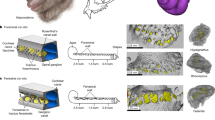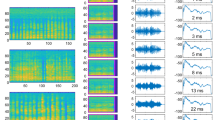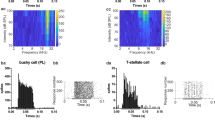Abstract
VESPERTILIONID bats produce FM echolocation pulses which sweep through a broad ultrasonic range1,2. Neurophysiological3,4 and behavioural5 evidence indicates that Myotis lucifugus, the most intensively studied of the vespertilionids, is maximally sensitive to the frequencies of its cries. The small size and mass of the middle ear structures in Microchiroptera6 suggest that the transduction system is specialized for the reception of ultrasound. It is obvious that the bat middle ear must respond to high ultrasonic frequencies, but it is not known how efficient the middle ear is, or whether this is achieved by tuned resonances or by a broad-band response. We have used the Mössbauer technique to investigate the contribution of the tympanic membrane to this high-frequency sensitivity. Although our primary interest was in the high-frequency response, we examined a broad range from 1 to 100 kHz.
This is a preview of subscription content, access via your institution
Access options
Subscribe to this journal
Receive 51 print issues and online access
$199.00 per year
only $3.90 per issue
Buy this article
- Purchase on Springer Link
- Instant access to full article PDF
Prices may be subject to local taxes which are calculated during checkout
Similar content being viewed by others
References
Henson, O. W., in The Biology of Bats (edit. by Wimsatt, W. A.) (Academic Press, London and New York, 1970).
Friend, J. H., Suga, N., and Suthers, R. A., J. Cell. Physiol., 67, 319 (1966).
Grinnell, A. D., J. Physiol., 167, 38 (1963).
Suga, N., J. Physiol., 172, 449 (1964).
Dallan, J. I., Science, 150, 1185 (1965).
Henson, O. W., Univ. Kansas. Sci. Bull., 42, 151 (1961).
Johnstone, B. M., and Boyle, A. J. F., Science, 158, 389 (1967).
Johnstone, B. M., Taylor, K. J.,and Boyle, A. J. F., J. Acoust. Soc. Amer., 47, 504 (1970).
Flanagan, J. L., J. Acoust. Soc. Amer., 34, 1370 (1962).
Mundie, J. R., in Middle Ear Function Seminar (edit. by Fletcher, J. L.) (US Army Medical Research Laboratory, Fort Knox, Report 576, 1963).
Zwislocki, J., J. Acoust. Soc. Amer., 35, 1034 (1963).
Khanna, S. M., and Tonndorf, J., Arch. Klin. Exp. Ohr. Nas. Kehlk. Heilk., 193, 78 (1969).
Author information
Authors and Affiliations
Rights and permissions
About this article
Cite this article
MANLEY, G., IRVINE, D. & JOHNSTONE, B. Frequency Response of Bat Tympanic Membrane. Nature 237, 112–113 (1972). https://doi.org/10.1038/237112a0
Received:
Issue Date:
DOI: https://doi.org/10.1038/237112a0
This article is cited by
-
Communication breakdown: Limits of spectro-temporal resolution for the perception of bat communication calls
Scientific Reports (2021)
-
The Foundations of High-Frequency Hearing in Early Mammals
Journal of Mammalian Evolution (2018)
-
Comparative Auditory Neuroscience: Understanding the Evolution and Function of Ears
Journal of the Association for Research in Otolaryngology (2017)
-
The Origins and Early Development of Australasian Auditory Neuroscience
Acoustics Australia (2016)
-
On population encoding and decoding of auditory information for bat echolocation
Biological Cybernetics (2010)
Comments
By submitting a comment you agree to abide by our Terms and Community Guidelines. If you find something abusive or that does not comply with our terms or guidelines please flag it as inappropriate.



